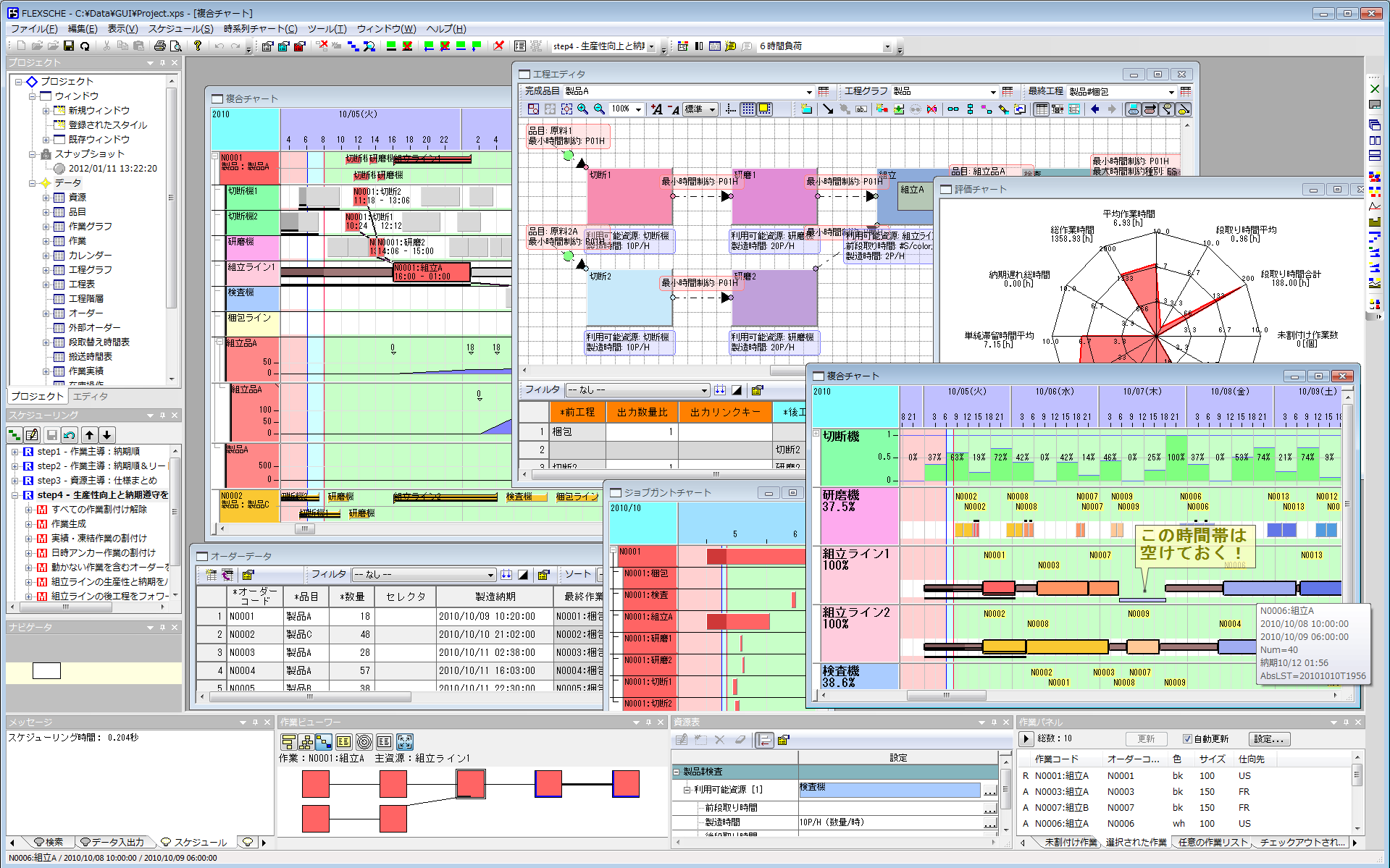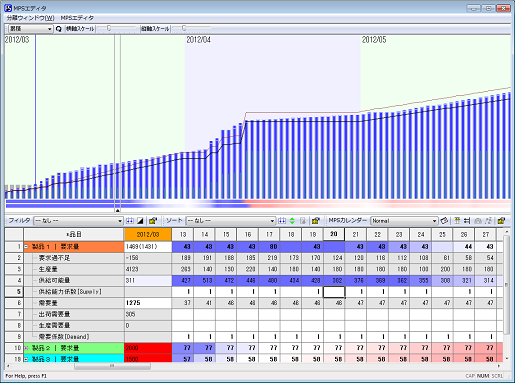Reducing Production Lead Time and Controlling Product Inventory Levels with the Production Scheduler FLEXSCHE
FLEXSCHE Corporation Mikio Urano
Article Published in 'IE Review' October 2012 Issue
1. FLEXSCHE
Due to significant changes in the environment surrounding the manufacturing industry in recent years, such as the shift to multi-product, small-lot production, the demand for quick delivery responses, and frequently changing production plans, much more precise factory operations are required compared to the past. The importance of production schedulers as an indispensable mechanism to achieve this is widely recognized and increasingly demanded.
The production scheduler FLEXSCHE, which is the focus of this article, is a package software developed with an emphasis on "flexibility" to meet the demands of a wide variety of manufacturing industries and "ease of use" to ensure continued use [Figure 1].

Figure 1 Production Scheduler FLEXSCHE
2. Reduction of Production Lead Time
It goes without saying that reducing production lead time has significant benefits, such as avoiding unnecessary delivery delays and improving cash flow by reducing idle and product inventory. However, many manufacturers struggle to achieve this.
In the traditional MRP approach, production lead time is the accumulation of "fixed lead times" that represent probabilistically anticipated rough process passage times [Figure 2]. Fixed lead times are one or several days, and in reality, unnecessary waiting times are wastefully incorporated. It's like a "rough estimate."
On the other hand, in production scheduling, each operation is simulated on a time axis in seconds, specifying which equipment will be used from when to when. Processes are meticulously modeled based on "net operation time," such as "it takes 2 minutes to process one item, so it takes 20 minutes to process 10 items," and setup times and transportation times between processes are also calculated in net time. Unreasonable waste is eliminated.
As long as plans are formulated by accumulating fixed lead times, squeezing a dry rag won't significantly shorten production lead time. For such factories, production scheduling may be the panacea for reducing production lead time.
Additionally, scheduling centered around bottleneck processes can be effective for some factories. In FLEXSCHE, planning procedures can be freely defined, such as controlling the execution order of bottleneck process operations to reduce total setup time and executing preceding and succeeding processes accordingly. This not only shortens the lead time of each lot but also improves the overall throughput of the factory.

Figure 2 Differences between MRP and Production Scheduling
3. Reduction of Planning Workload
The "reduction of planning workload" mentioned here does not simply refer to making the planner's job easier. It means that by reducing working hours, more time can be allocated to essential tasks such as negotiations with various departments accompanying planning and changes. There are still many planners who spend a lot of time on unproductive tasks, such as creating and updating plans by hand (including trial and error on Excel) and "redrawing lines" to accommodate rush orders.
With FLEXSCHE, by simply pressing the "reschedule" button, a plan that considers a vast number of constraints is instantly formulated, and work instructions can be issued quickly after making necessary adjustments. If operation result data from the manufacturing site is incorporated, it will be reflected in the next plan.
4. Production Scheduling in Forecast-Based Production
In make-to-order production, where production begins after the quantity and timing of shipments are confirmed, delivery delays and opportunity losses can be avoided by primarily focusing on manufacturing lead time at the production site. However, in other industries, the introduction of production schedulers may be hesitated due to their respective circumstances.
In industries such as food manufacturers and daily goods manufacturers, where production is always based on demand forecasts, or in industries such as automotive parts manufacturers and electronic parts manufacturers, where advance production is inevitable based on preliminary information, production begins when the quantity and timing of shipments are not yet confirmed. When the lid is opened, the shipment volume may be less or more than expected. If less, the surplus is accumulated as product inventory, and if more, the product inventory is depleted to respond. To avoid inventory risks (expiration, dead stock, cash flow deterioration) while avoiding delivery delays and opportunity losses, merely shortening manufacturing lead time is insufficient; rather, skillful control of product inventory levels (accelerator & brake) is strongly required.
While the importance of controlling product inventory levels in forecast-based production is recognized, finding the best approach has been difficult. Traditionally, in many manufacturing industries, the daily production volume obtained by dividing the monthly forecast demand for each product is regarded as the production volume to be achieved as the MPS (Master Production Schedule), and the sales department also relies on that quantity. When reality deviates from the forecast, the sales and production departments jointly hold a "sales-production adjustment meeting" to readjust the MPS. However, this method does not allow for swift and rational responses, and the manufacturing site is swayed by "demand uncertainty and probabilistic fluctuations," ultimately leading to
- Accumulation of product inventory
- Sudden stockouts occur
- The manufacturing site becomes confused
Such frequent problems cannot be avoided. Additionally, to allocate limited resources to multiple varieties in the manufacturing site, interference between varieties constantly occurs, but it is difficult to grasp the situation. If a stockout of one product is avoided, another product may suddenly be out of stock due to the lack of spare production capacity in the factory.
This is where the production scheduler demonstrates its power.
The production scheduler simulates future inventory level transitions based on the real production capacity of the factory, allowing even factories with complex processes and diverse product lines to instantly predict supply-demand balance transitions with high accuracy. By switching the flow of information from a one-way "MPS ⇒ Manufacturing Site" to a two-way "Production Planning ⇔ Production Scheduler," it becomes possible to directly address "demand uncertainty and probabilistic fluctuations."
This was realized with the release of FLEXSCHE d-MPS in 2012. It features a user interface for visually and comprehensively monitoring and intuitively adjusting the supply-demand balance transitions over the timeline [Figure 3]. The supply surplus and shortage status of each item, backed by production scheduling, is color-coded and displayed as warnings, allowing for adjustments to demand quantities and safety stock levels using the probabilistic fluctuation range (confidence level) as a guideline. As soon as a problem is foreseen, it can be promptly addressed.

Figure 3 FLEXSCHE d-MPS


